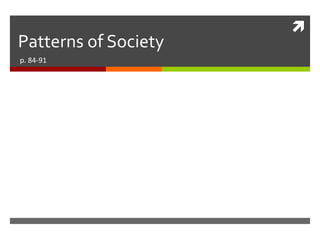
Patterns of Society
- 1. Patterns of Society p. 84-91
- 2. Social Mobility England: land was scarce, population large, a small but powerful group of landowners existed America: land was abundant, population small Relied less on land ownership than on control of a large workforce Social mobility was more possible in America
- 3. The Plantation First plantations emerged in VA and MD: tobacco Most were actually rough and small estates Indentured servants worked in tough conditions where daily deaths were common Workforce of a plantation was usually under 30 people
- 4. Plantation Economy Unstable economy: if markets were good, they could make profit If crop prices fell (tobacco in 1660’s), it could destroy the plantation Residents lived in a cluster of buildings since cities were sparse Wives of plantation owners relied on servants, they could then spend time on family
- 5. Plantation Slavery Smaller farms: not a rigid social separation between whites and blacks Larger plantations: ¾ of all blacks lived with at least 10 slaves, ½ with 50 or more to a plantation Africans developed a society and culture of their own
- 6. Plantation Slavery Slaves attempted to create nuclear families Could at times build stable households Problems: Any family member could be sold at any time Surrogate families were created to those sold
- 7. Slave Culture Slaves developed languages of their own Gullah: a hybrid of English and African Done to communicate so English masters couldn’t understand what they said Religion was blended as well: Christianity and African folklore were blended Treatment of slaves was very mixed; some were treated well, others brutally
- 8. Stono Rebellion Symbolizes the most important slave revolt SC in 1739 100 Africans rose up, seized weapons, and killed several whites Attempted to escape to FL Uprising quickly crushed, most were executed
- 9. Other Facts: Some slaves worked in the fields Others cooked for and raised the whites’ children Some learned trades such as blacksmithing, carpentry, shoemaking, spinning, weaving, sewing, etc… Craftsmen (and women) could be hired out to other planters Some could even buy freedom, but this was rare
- 10. Puritan Community Each settlement drew up a covenant among its members Bound all residents in a religious and social commitment to unity and harmony Towns had houses and a meeting house arranged around a central pasture or common Divided up the fields and woodlands among the residents
- 11. Puritan Community Size and location of a family’s field depended on the family’s numbers, wealth, etc… Families generally lived in the village with their neighbors close by Strong sense of community
- 12. Puritan Democracy A town was able to run its own affairs with little interference from the colonial gov’t Yearly town meetings were held Decided on important issues Chose “selectmen” who governed until the next meeting Adult males only allowed Church membership was required for full participation
- 13. Puritan Democracy Primogeniture-the passing of all inherited property to the firstborn son-did not take root in N.E. Fathers would divide land among all of his sons This control of inheritance was one of the most effective means of exercising power over male members of the family
- 14. Puritan Democracy Sons usually stayed close to their fathers after moving Women were more mobile, as their dowries were moveable objects (furniture, household goods, money, etc…) Population growth become the major issue with the Puritans, as it compromised their tight-knit community
- 15. Population Pressure As towns grew, residents cultivated land further from town centers Farmers wanted to be close to their land Some would ask to build a church out of town, which created new towns This led to conflict
- 16. Population Pressure As generations increased in number, inherited land was smaller and smaller by sons Other towns sprouting up limited the land available on edges of towns Sons had to leave the family to find enough land Fathers needed their sons income as much as the sons needed land: big problem! Family structure was weakened over time
- 17. Salem Witch Trials This is on pages 88-89. We will be going over this on Tuesday. Witchcraft spread through many N.E. towns in the 1690’s Most were middle-aged women with few or no children Most were of low social position Frequently accused of other crimes Witchcraft was a common feature of Puritan religious conviction
- 18. Growth of Colonial Cities See charts on p. 89! Growth of cities started slowly By 1770’s, Philly had 28,000 and NY had 25,000 people; Boston, Charleston, Newport Served as trading centers for farmers Leaders were mostly merchants In cities, social distinction was very evident
- 19. Commercial and Cultural Importance Cities were centers of industry Ironworks, distilleries for molasses What schools existed were in cities, as were shops and cultural activities Social problems existed: Crime, vice, pollution, epidemics, traffic (what kind of traffic??)
- 20. City Structure Set up constables offices, and fire dept’s Effects of prices on goods affected merchants and could be severe Newspapers were available, as were books Taverns and coffee houses provided a forum for people to discuss issues
- 21. Inequality John Winthrop: “Some must be rich, and some poor” Wealthy families had many more privileges in all areas of life Unlike any other time in history, the wealthy were actually the largest group of people in cities like Boston: this does not last!!